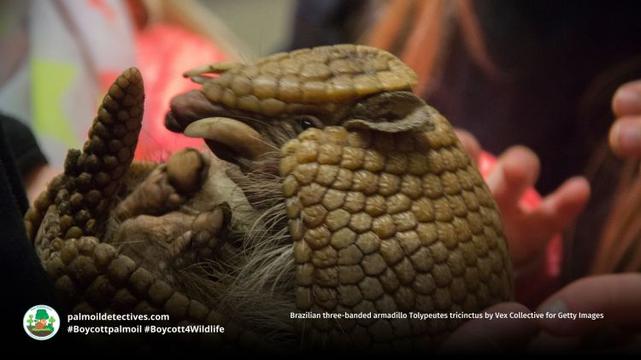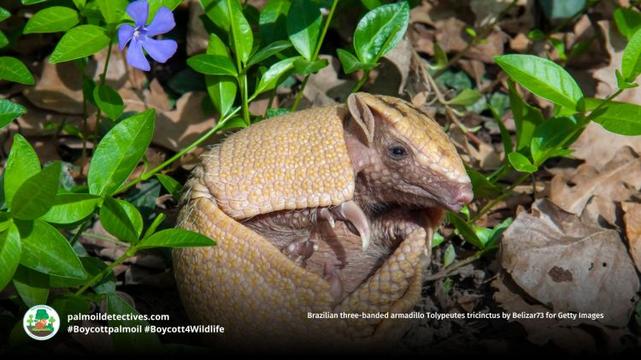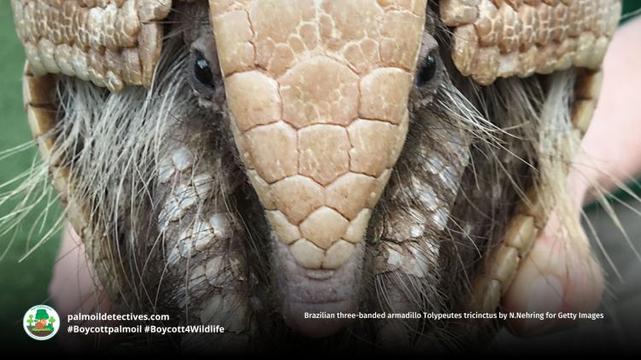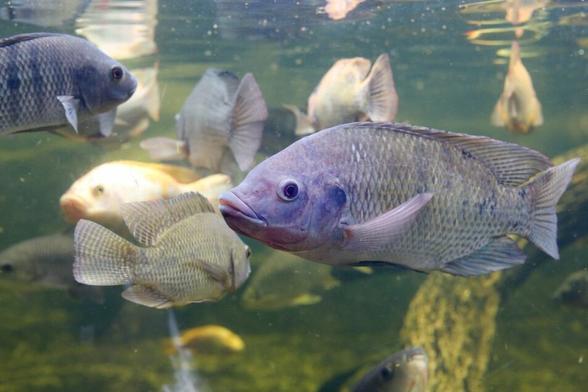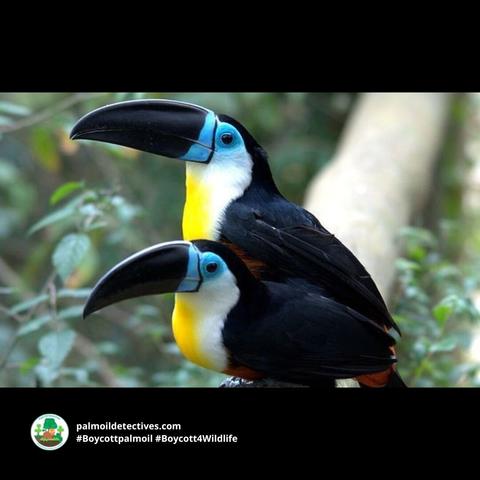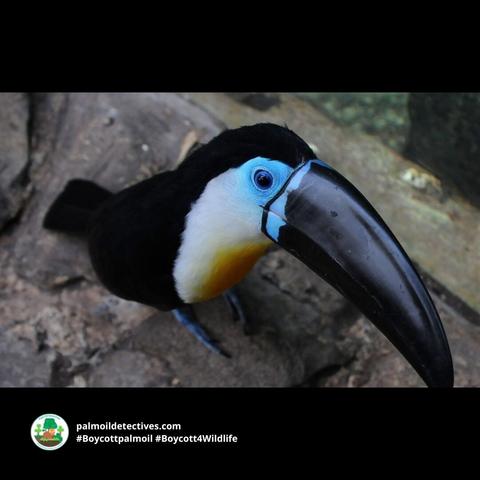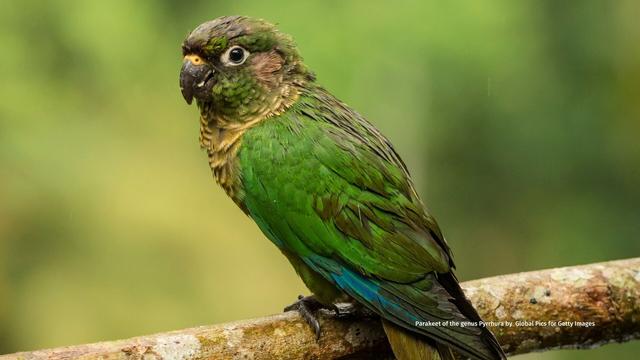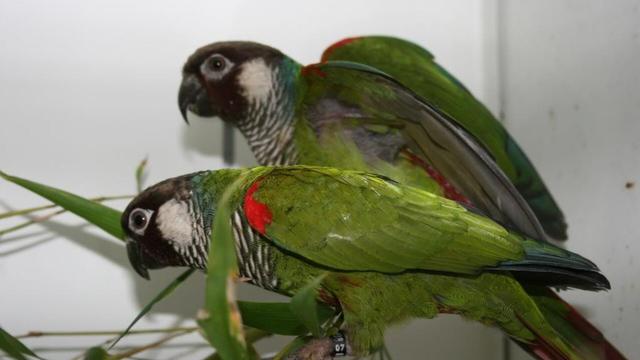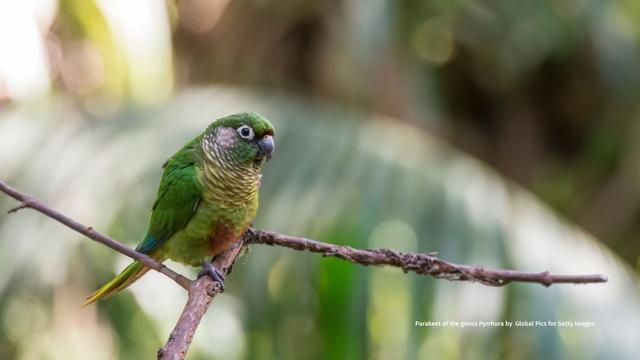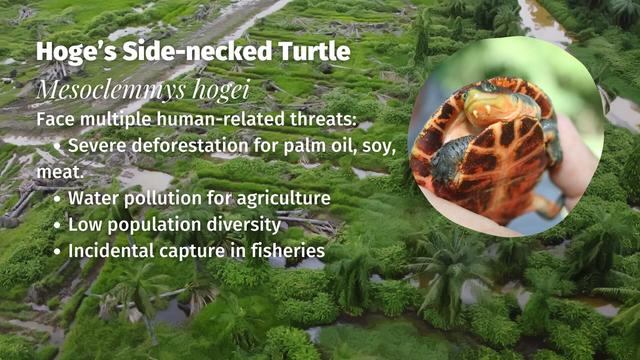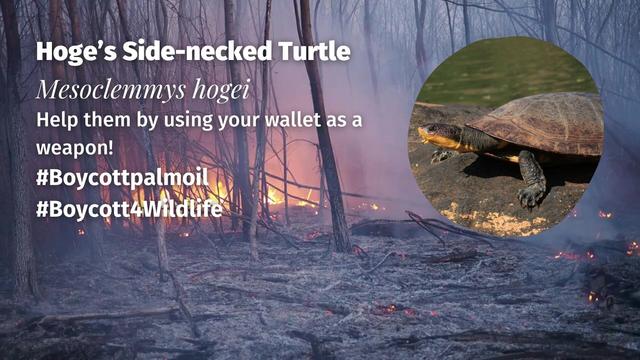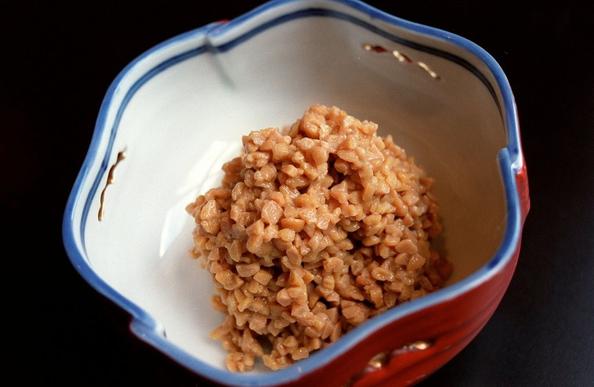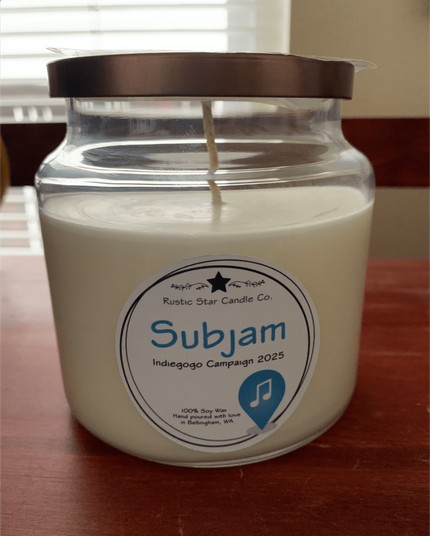I keep reading whining from the #MAGAs of #Nebraska
who lost the export market because of #Trump #tariff.
Sell your products in the USA
(after all it"s the only place where they buy them).
#Americans will have so much food at disposition that
it will necessarily cost less to the consumer... no ?
Tons of #soy and #chicken legs
and meat full of antibiotics (considered unsuitable for human nutrition outside the USA)
are waiting to be eaten by #US #consumers.
#Soy
DYK Orange-breasted 🦅 Falcon's striking orange 🧡 and black 🖤 plumage helps their courtship displays? 💕Sadly, these beautiful #birds are under threat from #palmoil #soy and #gold #deforestation. Help them and #BoycottPalmOil #Boycott4Wildlife 🌍✨ @palmoildetect.bsky.social https://wp.me/pcFhgU-8tM?utm_source=mastodon&utm_medium=Palm+Oil+Detectives&utm_campaign=publer
A stunning bright red face and shaggy coat give the Bald-headed Uacari a fairytale quality. They live in #Peru #Brazil and #Colombia in the #Amazon, threats incl. #palmoil #meat and #soy #deforestation. Take action! #Boycott4Wildlife
http://palmoildetectives.com/2021/02/24/bald-headed-uacari-cacajao-calvus/
Brazilian three-banded armadillo Tolypeutes tricinctus
Brazilian three-banded armadillo Tolypeutes tricinctus
Vulnerable
Extant (resident): Brazil: Minas Gerais, Bahia, Alagoas, Sergipe, Pernambuco, Rio Grande do Norte, Goiás, Tocantins, Piauí, Paraíba, Ceará, Maranhão.
The Brazilian three-banded #armadillo Tolypeutes tricinctus, known as “tatu-bola” in Portuguese, is a rare and unique species native to #Brazil. With the ability to roll into a near-impenetrable ball, this endearing behaviour has made them an icon of conservation efforts. They are found in the dry forests and savannahs of Brazil, particularly in the #Cerrado and Caatinga biomes. These fascinating armoured creatures are Vulnerable on the IUCN Red List due to agricultural expansion for #palmoil, #soy and #meat. Fragmentation of their ecosystem is ongoing for infrastructure projects and #goldmining. With their population in sharp decline, efforts to protect their habitats are essential for their survival. Help them every time you shop and adopt a #vegan diet, and #BoycottPalmOil #BoycottGold #Boycott4Wildlife on social media!
Resilient Brazilian three-banded #armadillos are fascinating real-life #pokemon of #SouthAmerica. They’re vulnerable from #palmoil meat and soy #deforestation in #Brazil. Resist their #extinction! Be #vegan #Boycottpalmoil #Boycott4Wildlife @palmoildetect https://wp.me/pcFhgU-8R9
Share to BlueSky Share to TwitterBrazilian three-banded #armadillos are the adorable armoured tanks of #Brazil’s #Cerrado who can curl into an armoured ball. They are #vulnerable from #deforestation. Help them survive by being #vegan and #Boycottpalmoil #Boycott4Wildlife @palmoildetect https://wp.me/pcFhgU-8R9
Share to BlueSky Share to TwitterAppearance & Behaviour
- The word “armadillo” means “little armoured one” in Spanish.
- They are known as ‘kwaráu’ in the now extinct Huamoé language and ˈkʌ̨́ñíkį̀ in the Kambiwá language of Brazil.
- Brazilian three-banded armadillos have a good nose and can smell termites and ants through up to 20 cm of soil.
- Their loose armour creates a layer of air, helping them to regulate their temperature in harsh climates.
- They are one of only two armadillo species that can roll into a tight ball.
Brazilian three-banded armadillos are easily recognised by their distinctive armour, which is composed of bony plates known as scutes. These scutes, covered in keratinised skin, form a protective shell around the animal’s body, allowing them to roll into a tight ball when threatened. This unique defence mechanism makes them virtually immune to most natural predators in the wild – except for humans. Their compact body length of 22 to 27 cm and a weight of about 1 to 1.6 kg makes it easy for them to navigate in the forest.
Their distinctive sharp claws and elongated snouts are perfectly adapted for foraging for ants and termites. Although primarily solitary, they sometimes travel in small family groups. They keep their noses to the ground sniffing out insects and move in a deliberate cautious way. Unlike other burrowing armadillos they prefer to hide in bushes for shelter and camouflage.
Threats
Deforestation for palm oil, soy and meat agriculture
Forest and grassland destruction for soy, palm oil, sugar cane and meat plantations is a serious threat. This has drastically reduced the Brazilian three-banded armadillo’s range in the Cerrado and Caatinga biomes.
Human encroachment for infrastructure projects
The Brazilian three-banded armadillo is impervious to many natural threats in their environment. However, infrastructure projects, roads, housing have become a significant threat to their survival.
Illegal hunting
Brazilian three-banded armadillos are hunted for their skins and meat.
Conservation
Conservation efforts for the Brazilian three-banded armadillo are indirect and focused on habitat protection rather than direct intervention. Protected areas within the Cerrado and Caatinga offer some refuge for the species. Yet large portions of their habitat remains at risk for deforestation.
Habitat
Resilient and tough, this armadillo has adapted over millions of years to thrive in harsh landscapes of poor rainfall and poor soil. Brazilian three-banded armadillos are found primarily in the northeastern regions of Brazil, inhabiting the open savannahs of the Cerrado and the dry woodlands of the Caatinga.
Diet
Brazilian three-banded armadillos are primarily insectivores, relying heavily on ants and termites as their main food source. Sharp claws allow them to dig into insect nests, and they use their long, sticky tongues to collect the prey. Occasionally they supplement their diet with molluscs, worms, fruit, and carrion.
Mating and breeding
The breeding season occurs between October and January. After a gestation period of approximately 120 days, females give birth to a single pup. Newborns are born blind, and their armour remains soft and pliable in the first weeks of life. A young armadillo’s shell hardens by week four. By this time they will be capable of protective rolling into a ball and walking. They are weaned by 10 weeks of age and reach reproductive maturity between 9 and 12 months.
Support Brazilian Three-Banded Armadillos by going vegan and boycotting palm oil in the supermarket, it’s the #Boycott4Wildlife
Support the conservation of this species
This animal has no protections in place. Read about other forgotten species here. Create art to support this forgotten animal or raise awareness about them by sharing this post and using the #Boycottpalmoil #Boycott4Wildlife hashtags on social media. Also you can boycott palm oil in the supermarket.
Further Information
Miranda, F., Moraes-Barros, N., Superina, M., & Abba, A. M. (2014). Tolypeutes tricinctus. The IUCN Red List of Threatened Species 2014: e.T21975A47443455. https://doi.org/10.2305/IUCN.UK.2014-1.RLTS.T21975A47443455.en
Wikipedia Contributors. (n.d.). Brazilian three-banded armadillo. In Wikipedia, The Free Encyclopedia. Retrieved September 16, 2024, from https://en.wikipedia.org/wiki/Brazilian_three-banded_armadillo
Animalia. (n.d.). Brazilian Three-Banded Armadillo. Retrieved from https://animalia.bio/brazilian-three-banded-armadillo
How can I help the #Boycott4Wildlife?
Take Action in Five Ways
1. Join the #Boycott4Wildlife on social media and subscribe to stay in the loop: Share posts from this website to your own network on Twitter, Mastadon, Instagram, Facebook and Youtube using the hashtags #Boycottpalmoil #Boycott4Wildlife.
Enter your email address
Sign Up
Join 1,390 other subscribers2. Contribute stories: Academics, conservationists, scientists, indigenous rights advocates and animal rights advocates working to expose the corruption of the palm oil industry or to save animals can contribute stories to the website.
Mel Lumby: Dedicated Devotee to Borneo’s Living Beings
Anthropologist and Author Dr Sophie Chao
Health Physician Dr Evan Allen
The World’s Most Loved Cup: A Social, Ethical & Environmental History of Coffee by Aviary Doert
How do we stop the world’s ecosystems from going into a death spiral? A #SteadyState Economy
3. Supermarket sleuthing: Next time you’re in the supermarket, take photos of products containing palm oil. Share these to social media along with the hashtags to call out the greenwashing and ecocide of the brands who use palm oil. You can also take photos of palm oil free products and congratulate brands when they go palm oil free.
https://twitter.com/CuriousApe4/status/1526136783557529600?s=20
https://twitter.com/PhillDixon1/status/1749010345555788144?s=20
https://twitter.com/mugabe139/status/1678027567977078784?s=20
4. Take to the streets: Get in touch with Palm Oil Detectives to find out more.
5. Donate: Make a one-off or monthly donation to Palm Oil Detectives as a way of saying thank you and to help pay for ongoing running costs of the website and social media campaigns. Donate here
Pledge your supportLearn about other animals endangered by palm oil and other agriculture
Global South America S.E. Asia India Africa West Papua & PNGBrazilian three-banded armadillo Tolypeutes tricinctus
Sumatran Tiger Panthera tigris sondaica
Bateleur Eagle Terathopius ecaudatus
Borneo Forest Dragon Gonocephalus bornensis
Orange-breasted Falcon Falco deiroleucus
Sunda Clouded Leopard Neofelis diardi
Learn about “sustainable” palm oil greenwashing
Read more about RSPO greenwashing
Lying Fake labels Indigenous Land-grabbing Human rights abuses Deforestation Human health hazardsA 2019 World Health Organisation (WHO) report into the palm oil industry and RSPO finds extensive greenwashing of palm oil deforestation and the murder of endangered animals (i.e. biodiversity loss)
Read more#animals #armadillo #armadillos #Bantrophyhunting #Boycott4wildlife #BoycottGold #BoycottPalmOil #Brazil #BrazilianThreeBandedArmadilloTolypeutesTricinctus #Cerrado #deforestation #extinction #ForgottenAnimals #goldMining #goldmining #hunting #meat #meatAgriculture #meatAndSoyDeforestationInBrazil #meatDeforestation_ #PalmOil #palmOilDeforestation #palmoil #poachers #poaching #pokemon #SouthAmericaSpeciesEndangeredByPalmOilDeforestation #SouthAmerica #soy #soyDeforestation #vegan #vulnerable #VulnerableSpecies
Are seed oils really bad for you?
Seed oils like canola and sunflower oil have attracted controversial claims about harmful effects in recent times.
Is there any truth to them?
#SeedOils #Health #Omega6 #Omega3 #Hexane #Canola #Corn #Cottonseed #Grapeseed #Soy #RiceBran #Sunflower #Safflower #AntiInflammatory #LinoleicAcid #Cholesterol #CardiovascularDisease #Diabetes
Santa Monica Seafood Atlantic Salmon Portions with Seafood Stuffing Have Undeclared Soy. #aldi #santamonicaseafood #salmon #soy #allergy #recall
https://www.instagram.com/p/DKQ8ARquUDi/
https://www.alojapan.com/1285631/japans-feed-one-to-build-aquafeed-mill/ Japan’s FEED ONE to build aquafeed mill #barley #canola #corn #CornMilling #CornWetMilling #feed #FeedMilling #FLOUR #FlourAdditives #FlourMilling #GrainIndustry #Japan #JapanNews #JapanTopics #maize #news #rapeseed #rice #SORGHUM #SoslandPublishing #soy #Soya #soybeans #wheat #WorldGrain TOKYO, JAPAN — FEED ONE Co. Ltd., a Japanese compound feed production and marketing company, announced plans to spend 13 billion yen ($89.7 million) to buil…
Colourful tree-dwellers Channel-billed Toucans are #Amazon #icons in #Brazil 🇧🇷#Venezuela 🇻🇪 #Colombia 🇨🇴 Threats include #PalmOil 🌴🔥#Soy #Meat 🥩🔥and #GoldMining 🥇🔥 Help them survive when you #BoycottPalmOil 🌴☠️🧐⛔️ #BoycottGold #Boycott4Wildlife https://palmoildetectives.com/2021/08/02/channel-billed-toucan-ramphastos-vitellinus/?utm_source=mastodon&utm_medium=Palm+Oil+Detectives&utm_campaign=publer
I have just realised #sainsburys have different skus for the chilled and non chilled #soy milk, and it's 30p more for the one in the fridge!
Sinu Parakeets are on a knife-edge of survival in #Colombia 🇨🇴 ravaged by #PalmOil #Soy and #Meat #Deforestation, they may now be lost 💔🙈 Help them and others survive before we never see them again. #BoycottPalmOil 🌴⛔️ #Boycott4Wildlife @palmoildetect https://palmoildetectives.com/2021/03/09/sinu-parakeet-pyrrhura-subandina/?utm_source=mastodon&utm_medium=Palm+Oil+Detectives&utm_campaign=publer
🎨🖌️ Ah, the fine #art of #soy sauce! It's like watching paint dry, but somehow even less thrilling. The #Guardian takes us on a magical #journey through endless paragraphs about #fermented bean juice, when all we really wanted was a #recipe. 🙄🍶
https://www.theguardian.com/world/2025/may/21/without-time-there-is-no-flavour-a-south-korean-grand-master-on-the-art-of-the-perfect-soy-sauce #sauce #food #HackerNews #ngated
For 80 million years Hoges Side-Necked 🐢💚#Turtles 💚🐢 have lived in #Brazil 🇧🇷. Now rampant #deforestation for #soy #palmoil #meat and hydroelectric dams threaten their survival, be #vegan and #BoycottPalmOil 🌴🩸🚜🔥⛔️ #Boycott4Wildlife @palmoildetect.bsky.social https://palmoildetectives.com/2021/03/11/hoges-side-necked-turtle-mesoclemmys-hogei/?utm_source=mastodon&utm_medium=Palm+Oil+Detectives&utm_campaign=publer
https://www.alojapan.com/1277859/go-try-japans-little-known-superfood/ Go try Japan’s little-known superfood #bean #dish #food #health #Japan #JapanNews #Japanese #JapaneseNews #natto #news #soy #SOYBEAN #zach You love sushi, ramen and tempura. But there’s another staple of Japanese cuisine that you probably don’t know about. It’s sticky and icky. It’s slimy and smelly. It’s ooey and gooey. It’s foamy and frothy. It’s phlegmy and cobwebby. It’s all natural, packed with protein and nutrients, and sells for…
New Grains Gluten Free Bakery Products contain undeclared eggs, soy, and milk. #newgrains #glutenfree #bakedgoods #eggs #soy #milk #allergy #recall
https://www.instagram.com/p/DJw8ZoTA_XA/
Global #deforestation 🌳🔥has increased for #palmoil 🌴🪔 #soy and #nickel finds new report. Meanwhile industry lobbyists have delayed EU #EUDR #CSDDD ban 👎 To save forests now we need strong laws! #Boycottpalmoil #Boycott4Wildlife @palmoildetect.bsky.social
https://wp.me/pcFhgU-8Ze?utm_source=mastodon&utm_medium=Palm+Oil+Detectives&utm_campaign=publer
Don't be fooled by #soy 🥜 it's a key driver of #Amazon #deforestation 🇧🇷🇵🇪🇪🇨 and illegal #landgrabbing from #Indigenous tribes. Mostly it's used to feed the animals we eat 🤮 To fight #extinction and cruelty be #vegan #Boycott4Wildlife
#plantbased #soy #protein I love soy curl jerky. Learned how to make it and it is one of my have in the fridge all the time snacks. Soy curls are not easy to get in Alaska. So I went directly to the manufacturer, a family business in Oregon. For a few dollars less then Amazon, I got the same 6 packages and they sent me a bonus. I recommend Butler Foods to those needing something a little different. It has lots of uses. I just happen to love the jerky.
This exclusive 100% soy wax scented candle can be yours if you pledge to our upcoming Indiegogo campaign at a VIP tier. We launch this Friday, May 16. Stay tuned, music lovers :)
Updates: https://subj.am
Custom candle by Bellingham, WA local Rustic Star Candle: https://rusticstarcandle.com
#music #localmusic #candles #soy #indiegogo #crowdfunding #perk #rusticstarcandle #custom
The influence of soy isoflavones on the course of menopause
Try eating 200g of tofu every day. The secret of this food product is very simple: it contains phytoestrogens, chemicals similar in properties to estrogens. Unlike estrogen, these substances act more gently, thus eliminating the discomfort associated with the onset of menopause.
The recommended daily intake of soy isoflavones is 60 mg/day, equivalent to 200 g of tofu.

